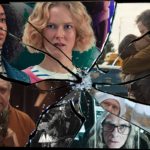This analysis contains spoilers for Barbie.
The new Barbie movie, directed by Greta Gerwig and starring Margot Robbie and Ryan Gosling, is a visual and thought-provoking feast of cinema. Inspired by the Mattel doll, created by Ruth Handler and launched in 1959, the movie follows the adventures of Stereotypical Barbie as she journeys from Barbieland to the real world to find out why she is malfunctioning. She is assisted by Ken, other Barbies, and real life “owner” Gloria and her daughter Sasha. Barbie discovers that the real world is not what she had been led to believe. Barbies were meant to inspire women, so that all issues of discrimination and feminism would be solved. Women in the real world were meant to enjoy fulfilled, perfect lives, just like in Barbieland. Instead, she finds patriarchy well and truly entrenched in America’s Los Angeles. Pointedly, she can’t solve or change that. She can, however, learn lessons on the way.
The Barbieland sets, props, and costumes are sumptuous and pay homage to real Barbie dreamhouses, accessories, and vehicles that have been available since the 1960’s. If you see it on the big screen, it really does feel like you are in a world of perfect plastic injection-moulded modernism. The Barbies interact in their world as if they are being played with. They don’t walk all the way through their multi-story house to get to the garage – they float from the roof straight into the car. There is no water – but they still have showers and pools. Food is a mixture of real containers and decals – they have meals but they don’t consume anything. The closet is arrayed like a Barbie boxed fashion set, with the outfit and matching accessories on display. The whole outfit magically transfers to Barbie and a new outfit for the next day appears in its place.
Barbie plays every role from President to garbage collector. She posts the mail and explores space, she is a doctor and a chef. She is a lawyer and an athlete. She is a Supreme Court judge and a construction worker. She is a nurse, a pilot, a builder, a teacher, and a vet. Everything is open to her and she is capable of achieving anything she puts her mind to.
The easter eggs for Barbie fans are innumerable. Look for the letter B hidden in carpet, logos and architecture. There are references to previous animated Barbie movies and television series. One Barbie is seen reading the Barbie magazine, which has been published from 1978, under different publishers. Skipper’s treehouse was a real playset. The camper, spaceship, boat, and Corvette that Barbie uses to get to and from the real world were all based on released toys. There were nods to discontinued dolls, and the controversies they sparked, like Growing Up Skipper, Earring Magic Ken, and pregnant Midge, one of Barbie’s friends. Margot Robbie has been seen wearing outfits on her press tour that are inspired by Barbie dolls throughout her 64 year history.
While Barbie is a fun heroine’s journey, there is a depth of thought that has been injected into this movie that begs a closer look.
There are two things, amongst a cornucopia of concepts that this movie raises, that are worth exploring: the role of women in the modern world and the problem of patriarchy.
The very first teaser trailer, which was expanded to become the opening scene, was inspired by Stanley Kubrick’s 2001: A Space Odessey, complete with Richard Strauss’ Thus Spoke Zarathustra score. It describes how girls had played with dolls since the beginning of time, but they were always baby dolls. This offered only one avenue of play – that of being mothers. Historically, there is some truth to this. The Twentieth Century Toy Museum in Carcoar describes how Barbie completely changed the world of dolls. Before Barbie, girls mostly had “daughter” dolls that they had to care for. After Barbie, girls suddenly had a big sister that they could look up to and be inspired by. Barbie offered options for what they could do with their lives that had not been seen before.
While this might be an oversimplification, the restriction on women to be solely valued in terms of their relationship to others, wife, mother, daughter, etc., is part of what feminism has strived to critique. There has been a cost for women in moving beyond the household realm. The burden of carrying the mental load, still doing the vast majority of housework while holding down work as well, impossible, and often double, standards to uphold (some of which the movie fairly critiques Barbie as representing), are things that modern women express.
The climax of the movie is arguably Gloria’s monologue after Barbie despairs that she is not pretty enough, not smart enough to be interesting, just not good enough.
The speech enables the brainwashed Barbies to be freed from the patriarchal change that Ken has brought with him from the real world. It laments the impossibility of being a woman.
It is literally impossible to be a woman. You are so beautiful, and so smart, and it kills me that you don’t think you’re good enough. Like, we have to always be extraordinary, but somehow we’re always doing it wrong.
You have to be thin, but not too thin. And you can never say you want to be thin. You have to say you want to be healthy, but also you have to be thin. You have to have money, but you can’t ask for money because that’s crass.
You have to be a boss, but you can’t be mean. You have to lead, but you can’t squash other people’s ideas. You’re supposed to love being a mother, but don’t talk about your kids all the damn time. You have to be a career woman, but also always be looking out for other people.
There is a moment in the film that was inspired by Michealangelo’s Creation of Adam. Barbie meets her maker, Ruth Handler, and they touch hands as Barbie receives a cup of tea while trying to escape the, ironically, all-male executive of Mattel who are trying to force her to, literally, get back in her box.
Women, the same as men, are made in the image of God. They are made to be creative, just like God is creative. They are made to be loving, just like God is love. They are made to be strong, just like God. There is no human emotion or trait that is exclusively male or female. They are human because they come from God, having been made in God’s image. Relegating any gender to roles that are limiting or oppressive goes against the nature of the created being. Humans are not their jobs, or their relationships, or their possessions, or their interests. They are images of the living, creative, powerful God, and, as such, worthy of love, nurture, and immeasurable value.
One of the major themes of Barbie is how destructive patriarchy can be to the lives of girls and women. As Ken puts it, “Everything exists to extend the presence of men”. Barbie and he have very different experiences of rollerblading upon arriving in Los Angeles. Ken feels looked up to, seen, valued, “admired but not ogled”. He experienced respect just for who he was. Barbie, on the other hand, is uneasy, feels unsafe, and recognises an undercurrent of violence.
Sadly, Barbieland is not that much better than the real world. Ken observes that they are the reverse of each other. He only has a good day when Barbie looks at him. The Kens are seen as superfluous in this world. They are not valued nor full participants in society. Barbie doesn’t even know where Ken goes at night. The Kens in Barbieland get to experience what so many women experience in the real world.
In both worlds, someone is being, at least, devalued and taken for granted, at worst, oppressed and abused.
At the very end of the movie, the creator Ruth Handler, spends time with Barbie on her own. She explains that being human is complicated and messy. People invent things like Barbie and patriarchy to deal with the uncomfortableness of being human. She’s got a point.
No human governmental system, cultural expression or national identity has ever fully valued all people, regardless of race, gender, or any other factor. Being human constructs, they are flawed.
Gloria encourages Barbie, and therefore us, that we still need to try. While there is no possible way that human beings can ever make the world perfect, they can strive to make it better. For Christians, that will possibly be best expressed by participating in what God is already doing in the world.
Dr Katherine Grocott











